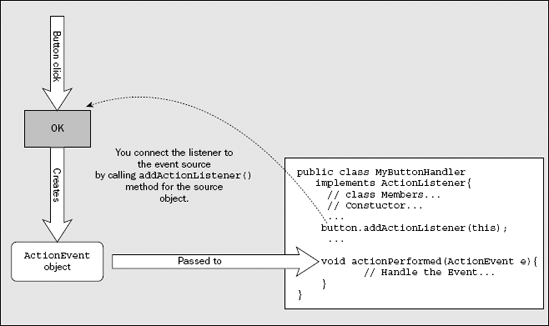18.2. The Event-Handling Process
To manage the user's interaction with the components that make up the GUI for a program, you must understand how events are handled in Java. To get an idea of how this works, let's consider a specific example. Don't worry too much about the class names and other details here. Just try to get a feel for how things connect.
Suppose the user clicks a button in the GUI for your program. The button is the source of this event. The event that is generated as a result of the mouse click is associated with the JButton object in your program that represents the button on the screen. An event always has a source object—in this case the JButton object. When the button is clicked, it creates a new object that represents and identifies this event—in this case an object of type ActionEvent. This object contains information about the event and its source. Any event that is passed to a Java program will be represented by a particular event object—and this object will be passed as an argument to the method that is to handle the event. Figure 18-2 illustrates this mechanism.
Figure 18.2. Figure 18-2

The event object corresponding to the button click will be passed to any listener object that has previously registered an interest in this kind of event—a listener object being simply an object that listens for particular events. A listener is also called a target ...
Get Ivor Horton's Beginning Java™ 2, JDK™ 5th Edition now with the O’Reilly learning platform.
O’Reilly members experience books, live events, courses curated by job role, and more from O’Reilly and nearly 200 top publishers.

